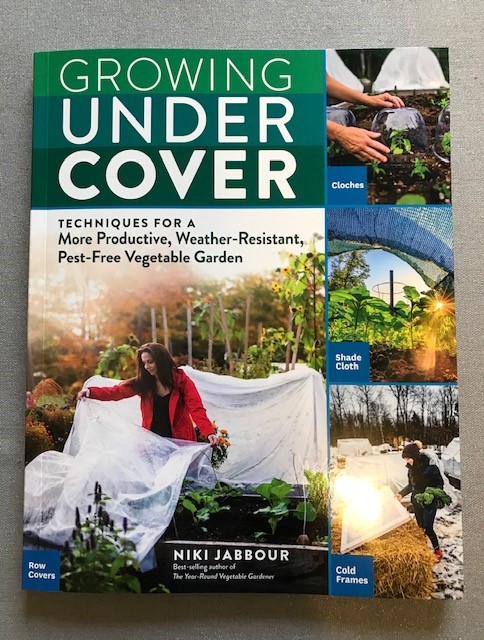Book Review: Growing Under Cover
Growing Under Cover by Niki Jabbour (Storey Publishing, 216 pp., 2020, $24.95)
by Susan Mulvihill
I’ve known for several months that Niki Jabbour’s new book, Growing Under Cover, would be coming out in December 2020 and have been so excited to read it! I’m a huge fan of hers: she lives in Halifax, Nova Scotia, where she gardens year-round despite their tough winters. Niki’s first book, The Year-Round Vegetable Gardener, inspired me to grow food 12 months of the year and also to grow out-of-the-ordinary vegetables.
Her other books are Ground-Breaking Food Gardens and Veggie Garden Remix; all of them have been best-sellers.
In Growing Under Cover, Niki explains the many beneficial uses for each type of cover, which include cloches, cold frames, insect barriers, row covers, shade cloth, low tunnels, greenhouses, bioshelters, polytunnels, and geodesic domes.
You might think this book only applies to folks who garden in cold climates, but it’s filled with tips for those growing in warm climates as well, where covers can protect plants from the heat and help with seed germination by keeping the soil from drying out.
What I really like about this book is how Niki relates exactly how she uses each type of cover or structure in her own garden, along with sharing information on some gardeners who utilize other types of structures.
In chapter three, Niki focuses on gardening in polytunnels. After researching them and then having one erected in her garden last year, she has plenty of tips to relay to the reader: pick a sunny site, orient them east/west to maximize the light, put them close to a water source and electricity, how to prepare the site prior to erecting one, how they assembled theirs, and exactly how they use it.
In the following chapter, she explains how using covers in the spring allows gardeners to start plants earlier, pre-warm the soil surface with plastic mulch, and help harden-off seedlings. Niki also discusses ways to grow plants vertically in a structure in order to use the space well while keeping them healthy.
She also shares her 12-month calendar for growing under covers, whether it’s in the polytunnel, in cold frames, or by using covers out in the garden. She explains how crop rotation works in the garden and that it’s just as important within a structure.
In chapter five, “Setting up systems,” the author relates how she controls temperature, humidity, takes advantage of heat retention, and maximizes the heat in structures – all while underscoring the importance of good ventilation and proper watering.
Chapter six, “Preventing diseases, pests and poor pollination,” is filled with smart, sensible tips for keeping plants healthy. Niki writes about the most common diseases, what each one is, how it affects plants, and how to get rid of it. There are simple organic solutions and strategies for dealing with them. She even includes ways to attract both pollinators and beneficial insects into structures so they can work their magic.
Gardeners will appreciate Part Two, “Vegetables that love a cover,” because they’ll find tips on growing different crops and strategies for helping them grow. These include using covers for things like frost protection, overwintering, pest prevention, and shading some crops to prevent bolting in hot weather.
As I read Growing Under Cover, I continually found myself jotting down “note to self” items about new techniques to try that I’d never thought of before. Now I can’t wait for the new garden season to begin!
Just as with Niki’s previous books, Growing Under Cover is packed with useful information that every gardener can benefit from. The result will be even more success at growing a garden!

